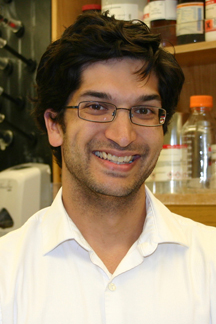New Chemistry Technique Reproduces Nature’s Elusive Complexity
Scientists at The Scripps Research Institute have shown how to synthesize in the laboratory an important set of natural compounds known as terpenes. The largest class of chemicals made by living organisms, terpenes are made within cells by some of the most complex chemical reactions found in biology.
The new technique, described in an advance online edition of the journal Nature Chemistry on September 23, 2012, mimics a crucial but obscure biochemical phenomenon that allows cells to make terpenes. The discovery may one day result in cheaper, fully synthetic versions of the cancer drug Taxol, the antimalarial compound artemisinin, and hundreds of other useful terpene products.
“It’s exciting for us because we’re now making molecules that have never been made in the laboratory before, and we’ve done this by first observing what nature does,” said the senior investigator for the study Ryan A. Shenvi, a chemist at Scripps Research.
Powerful Biological Functions
Terpenes take their name from one of their best-known representatives, the paint thinner turpentine—a derivative of pine sap. Many terpenes, like those in turpentine, are small, plant-made molecules that turn into vapor at relatively low temperatures and waft easily through the air. These often serve as important chemical signals for plants and are used by humans in fragrances and flavorings.
Some terpenes are more complex and are synthesized by plants and other organisms as powerful cellular defense mechanisms. “Having such strong biological functions can make them very useful in medicine,” said Shenvi. Paclitaxel (Taxol), a widely used cancer drug, is a terpene derived from the bark of the Pacific yew tree. Artemisinin, the basis for a major class of antimalarial therapy, is a terpene made by the sweet wormwood herb. But the terpene family is highly diverse and also includes vitamin A, menthol, cholesterol, and steroids.
Many terpenes, including Taxol and artemisinin, are made naturally in cells by processes that are so complicated, and so hard to understand, that chemists haven’t been able to recreate them fully using organic chemistry techniques. The commercial production of these two medicines still depends on the relatively expensive harvesting of starting compounds from plants.
Taking Up the Challenge
In the new study, Shenvi and a postdoctoral researcher in his laboratory, Sergey V. Pronin, set out to recreate one of the two major terpene synthesis processes in nature. Known as tail-to-head polycyclization, this process is used by cells to make numerous complex terpenes. (The other major terpene synthesis process, head-to-tail polycyclization, is already partially reproducible with organic chemistry and results in terpenes that include steroids.)
The tail-to-head polycyclization process begins with a relatively simple chain of carbon atoms, each of which is decorated with other, mostly hydrogen atoms. The goal of the process is to bend this linear hydrocarbon structure in a way that yields one ringlike structure, then another, and so on in a “polycyclic” chain.
A crucial feature of this process is the effective displacement of positive charge from one carbon atom on the structure to another, in just the right sequence. What makes this feat so challenging for chemists to reproduce, and even to analyze, is that this positively charged state in principle can slide along numerous alternative pathways on the emerging structure. Moreover, because it powerfully attracts negatively charged ions, this carbon-based positive charge, which chemists refer to as a carbocation [“carbo-cat-eye-on”], is inclined to snuff itself out almost immediately.
“Carbocations are notoriously tricky to include in synthetic procedures in the laboratory, because their lifetimes are so short,” said Shenvi. “And yet nature has evolved tools to handle them.”
Chief among these tools are cyclase enzymes, which hold terpene molecules that are under construction and use their own charged structures to protect carbocations from being quenched—at least long enough to let them do their work. Chemists who have sought to synthesize terpenes in the laboratory generally have done so without trying to mimic these enzymes’ charge sequestration mechanism.
“The natural synthetic pathways were assumed to be much too difficult and maybe impossible,” Shenvi said. “But we decided that we would have to recreate it somehow if we wanted to develop a broadly useful technique for making this group of terpenes.”
Following Nature’s Lead
Shenvi continued, “We wanted to understand why Nature’s cyclase enzymes work so efficiently, so we interrogated the chemical reactions that they use and in the process discovered new basic reactivity.”
Pronin and Shenvi eventually found that a type of vinyl epoxide seems to serve as a partial substitute for cyclase enzymes. “We think that it effectively holds the negatively charged counteranion, which would otherwise follow and quench the carbocation before the reaction is complete,” said Pronin.
As a demonstration of the power of their new technique, the chemists used it to make two different types of terpene, known as funebrene and cumacrene, starting from relatively simple organic chemistry ingredients. These terpene compounds had never before been fully synthesized outside of living cells.
Shenvi emphasizes that this report represents merely an initial, foundational description of this new strategy and that technical obstacles still prevent its widespread use. “But once we can get past these obstacles, we should be able to use this new approach to fully synthesize many other valuable compounds,” he said. “Basically the entire realm of terpenes will be reproducible with organic chemistry.”
Funding for the study, “Synthesis of highly strained terpenes by non-stop tail-to-head polycyclization,” was provided by a start-up grant from the Scripps Research Institute and a grant from Eli Lilly & Co.
For more information on the paper (doi:10.1038/nchem.1458), see http://www.nature.com/nchem/journal/vaop/ncurrent/abs/nchem.1458.html.
Send comments to: press[at]scripps.edu















